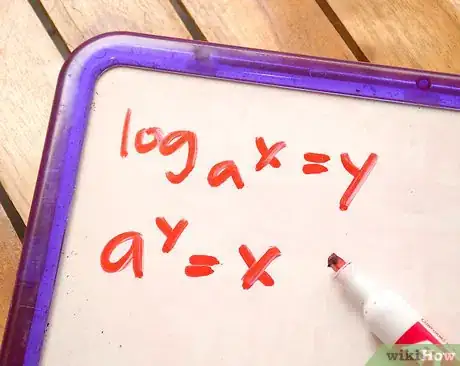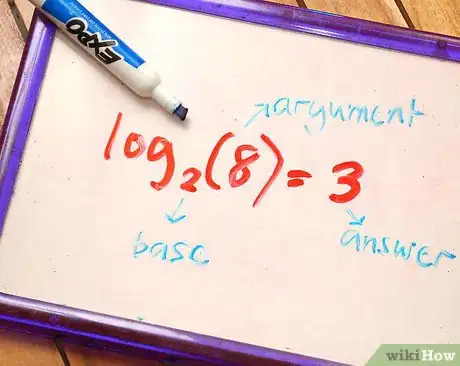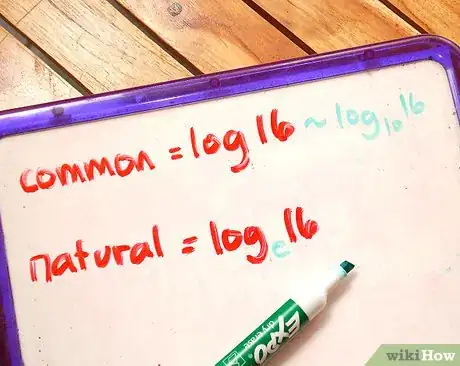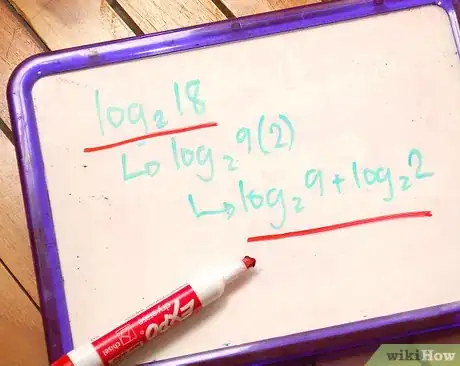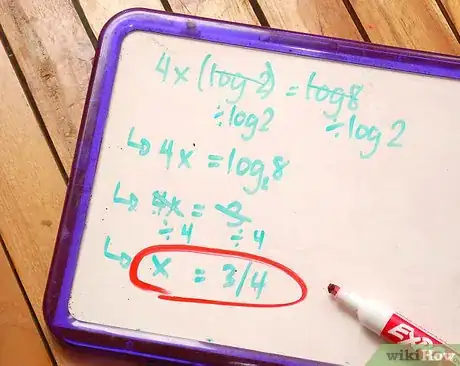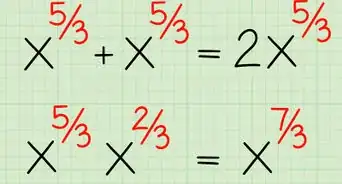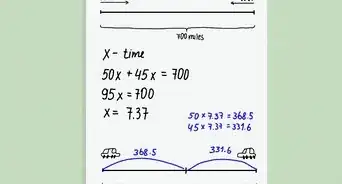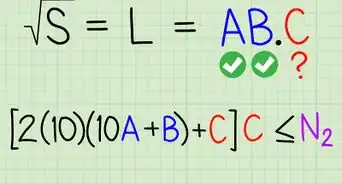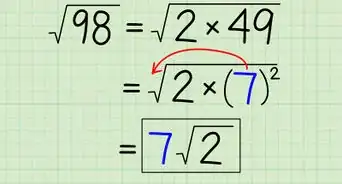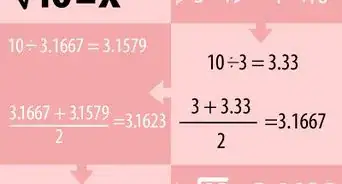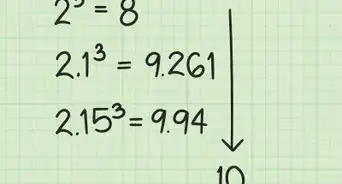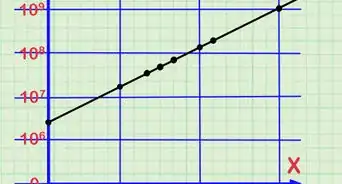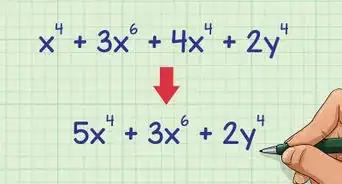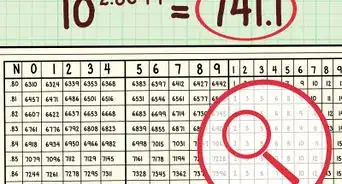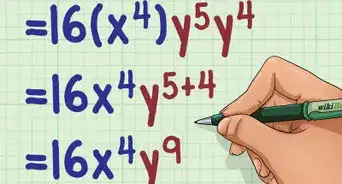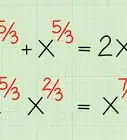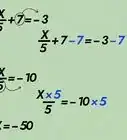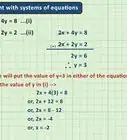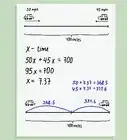X
wikiHow is a “wiki,” similar to Wikipedia, which means that many of our articles are co-written by multiple authors. To create this article, 28 people, some anonymous, worked to edit and improve it over time.
There are 7 references cited in this article, which can be found at the bottom of the page.
This article has been viewed 364,622 times.
Learn more...
Confused by the logarithms? Don't worry! A logarithm (log for short) is actually just an exponent in a different form. The important thing to understand about logarithms is why we use them, which is to solve equations where our variable is in the exponent and we can't get like bases.[1]
logax = y is the same as ay = x.
Steps
-
1Know the difference between logarithmic and exponential equations. This is a very simple first step. If it contains a logarithm (for example: logax = y) it is logarithmic problem. A logarithm is denoted by the letters "log". If the equation contains an exponent (that is, a variable raised to a power) it is an exponential equation. An exponent is a superscript number placed after a number.[2]
- Logarithmic: logax = y
- Exponential: ay = x
-
2Know the parts of a logarithm. The base is the subscript number found after the letters "log"--2 in this example. The argument or number is the number following the subscript number--8 in this example. Lastly, the answer is the number that the logarithmic expression is set equal to--3 in this equation.[3]Advertisement
-
3Know the difference between a common log and a natural log.[4]
- Common logs have a base of 10. (for example, log10x). If a log is written without a base (as log x), then it is assumed to have a base of 10.
- Natural logs: These are logs with a base of e. e is a mathematical constant that is equal to the limit of (1 + 1/n)n as n approaches infinity, which is approximately equal to 2.718281828. The larger the value we plug in for n, the closer we get to 2.71828. It's important to understand that 2.71828 or e is not an exact value. You can think of it like the value of pi where there is an infinite number of digits after the decimal place. In other words, it's an irrational number that we round to 2.71828. Also, logex is often written as ln x. For example, ln 20 means the natural log of 20 and since the base of a natural log is e, or 2.71828, the value of the natural log of 20 is approximately equal to 3 because 2.71828 to the 3rd is approximately equal to 20. Note than you can find the natural log of 20 on your calculator using the LN button. Natural logs are critical for the advance study of math and science and you will learn more about their uses in future courses. For the time being however, it's important to become familiar with the basics of natural logarithms.
- Other Logs: Other logs have the base other than that of the common log and the E mathematical base constant. Binary logs have a base of 2 (for the example, log2x). Hexadecimal logs have the base of 16. Logs that have the 64th base are used in Advanced Computer Geometry (ACG) domain.
-
4Know and apply the properties of logarithms. The properties of logarithms allow you to solve logarithmic and exponential equations that would be otherwise impossible.[5] These only work if the base a and the argument are positive. Also the base a cannot be 1 or 0. The properties of logarithms are listed below with a separate example for each one with numbers instead of variables. These properties are for use when solving equations.[6]
- loga(xy) = logax + logay
A log of two numbers, x and y, that are being multiplied by each other can be split into two separate logs: a log of each of the factors being added together. (This also works in reverse.)
Example:
log216 =
log28*2 =
log28 + log22 - loga(x/y) = logax - logay
A log of two numbers being divided by each other, x and y, can be split into two logs: the log of the dividend x minus the log of the divisor y.
Example:
log2(5/3) =
log25 - log23 - loga(xr) = r*logax
If the argument x of the log has an exponent r, the exponent can be moved to the front of the logarithm.
Example:
log2(65)
5*log26 - loga(1/x) = -logax
Think about the argument. (1/x) is equal to x-1. Basically this is another version of the previous property.
Example:
log2(1/3) = -log23 - logaa = 1
If the base a equals the argument a the answer is 1. This is very easy to remember if one thinks about the logarithm in exponential form. How many times should one multiply a by itself to get a? Once.
Example:
log22 = 1 - loga1 = 0
If the argument is one the answer is always zero. This property holds true because any number with an exponent of zero is equal to one.
Example:
log31 =0 - (logbx/logba) = logax
This is known as "Change of Base".[7] One log divided by another, both with the same base b, is equal to a single log. The argument a of the denominator becomes the new base, and the argument x of the numerator becomes the new argument. This is easy to remember if you think about the base as the bottom of an object and the denominator as the bottom of a fraction.
Example:
log25 = (log 5/log 2)
- loga(xy) = logax + logay
-
5Practice using the properties. These properties are best memorized by repeated use when solving equations.[8] Here's an example of an equation that is best solved with one of the properties:
4x*log2 = log8 Divide both sides by log2.
4x = (log8/log2) Use Change of Base.
4x = log28 Compute the value of the log.
4x = 3 Divide both sides by 4. x = 3/4 Solved. This is very helpful. I now understand logs.
Advertisement
Community Q&A
-
QuestionCan you provide some exam style questions of logarithms?
 Community AnswerHere are some few practice problems : 1. log(3 + 2 log(1+x) ) =0 , Find x 2. If (2.5)^x = 0.025)^y, find x and y.
Community AnswerHere are some few practice problems : 1. log(3 + 2 log(1+x) ) =0 , Find x 2. If (2.5)^x = 0.025)^y, find x and y. -
QuestionHow do I find an answer for 6=log(x/5)?
 Community AnswerYou must expand the expression to 6=log(x)-log(5). This is an example of the quotient property of a logarithm log(a/b)=log(a)-log(b). You then do log(5), which is approximately 0.699, so 6=log(x)-0.699. Add 0.699 to both sides to get 6.699=log(x). Then rewrite it in exponential form as 10^6.699=x and do the rest.
Community AnswerYou must expand the expression to 6=log(x)-log(5). This is an example of the quotient property of a logarithm log(a/b)=log(a)-log(b). You then do log(5), which is approximately 0.699, so 6=log(x)-0.699. Add 0.699 to both sides to get 6.699=log(x). Then rewrite it in exponential form as 10^6.699=x and do the rest. -
QuestionHow do you get ln(y)?
 Community AnswerThe ln(y) function is similar to a log function. A log function uses a base of ten (log base ten of x is often written log(x)), unless otherwise specified. A function ln(x) is just a logarithm with a base of e, a number that is similar to pi in the fact that it is a mathematical constant. The letter e represents the number 2.71828. So, ln(y) is equivalent to log of y with a base of e, or log base e of y.
Community AnswerThe ln(y) function is similar to a log function. A log function uses a base of ten (log base ten of x is often written log(x)), unless otherwise specified. A function ln(x) is just a logarithm with a base of e, a number that is similar to pi in the fact that it is a mathematical constant. The letter e represents the number 2.71828. So, ln(y) is equivalent to log of y with a base of e, or log base e of y.
Advertisement
Videos on Properties
References
- ↑ https://www.mathsisfun.com/algebra/logarithms.html
- ↑ https://www.youtube.com/watch?v=K_PiPfYxtao
- ↑ https://www.mathsisfun.com/algebra/logarithms.html
- ↑ https://www.purplemath.com/modules/logs3.htm
- ↑ https://www.khanacademy.org/math/algebra2/exponential-and-logarithmic-functions/properties-of-logarithms/a/properties-of-logarithms
- ↑ https://www.khanacademy.org/math/algebra2/x2ec2f6f830c9fb89:logs/x2ec2f6f830c9fb89:log-prop/a/properties-of-logarithms
- ↑ http://en.wikipedia.org/wiki/Logarithms Logarithms - Wikipedia
- ↑ https://tutorial.math.lamar.edu/classes/alg/logfunctions.aspx
About This Article
Advertisement
